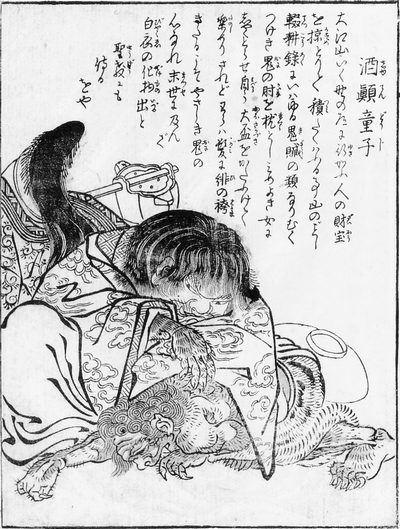
Northwest of Kyoto, there is a mountain called Mount Ōe (大江山) that holds an oni lair. An ancient lair that was owned by the notorious oni king called Shuten-dōji. Without a doubt, he is one of the three most feared yokai of ancient Kansai region, including Tamamo-no-Mae (玉藻前) and Ōtakemaru (大嶽丸). Shuten-dōji is the original oyabun that terrorized the people of Kyoto with his dreaded gang of oni.
As it was written in the narrative Ōeyama Ekotoba (大江山絵詞), Shuten-dōji continually raided the northern region of Kyoto. Incessantly, the oni king and his gang looted and plundered the province in a drunken fury. Moreover, Shuten-dōji kidnapped young women and forced them to serve as his private maidservants. Those who refused were eaten and their blood were drunk with sake.
Over the years, Shuten-dōji‘s notoriety attracted hundreds of oni from across Japan. Moreover, his top lieutenants were fearfully called the “Four Divine Kings”. Their names were Hoshikuma-dōji, Kuma-dōji, Torakuma-dōji, and Kane-dōji. Furthermore, Shuten-dōji has a favourite underling, Ibaraki-dōji. who was menacing in his own right. Because of the immense power and influence of Shuten-dōji, he threatens the reigning Emperor of Japan.

Ibukiyama Version
Alternatively, in the Mt. Ibuki (伊吹山) legend, Shuten-dōji was born to the great serpent Yamata no Orochi (八岐大蛇). Although he went through monk training at Mt. Hiei, Shuten-dōji continued to drink heavily. Consequently, he got intoxicated during a religious festival. Moreover, he played a prank on his fellow acolytes by wearing an oni mask to frighten them. Consequently, at the end of the night, the mask has melded to Shuten-dōji‘s face.
Because he was unable to remove the oni mask, Shuten-dōji fled to forests of Mt. Ibuki. Initially regretful, he turned wicked. As such, he began his life as a true oni. Shuten-dōji terrorized the people of Kyoto and formed a gang of oni. Afterwards, he built his fortress high up in the mountains. Interestingly, in this Ibukiyama version, Shuten-dōji‘s honji (本地), “true nature”, was identified to be Dairokuten no Maō (第六天の魔王) the evil king of the Sixth Heaven, the archenemy of Buddha.
Downfall of the Oni King
Finally, Emperor Ichijō commanded his mightiest samurai to subdue the oni king Shuten-dōji. Immediately, the supernatural warriors travelled to Mt. Ibuki disguised as yamabushi priests. After discovering the hideout, they requested an audience with Shuten-dōji. As such, the oni king had a grand reception for his guests. Covertly, the disguised warriors offered Shuten-dōji with an enchanted sake. Eventually, after countless drinks later, the notorious oni fell asleep. At this moment, the inhuman samurai, Minamoto no Raikō, chopped off Shuten-dōji‘s head with Dōjigiri (童子切), the legendary sword.
Yokai Details
- name: shuten-doji (sho-ten-doe-jee)
- kanji: 酒呑童子 ( しゅてんどうじ )
- alternative spelling: 酒顛童子, 酒天童子, 朱点童子
- meaning: sake drinking child
- abilities:
- supernatural strength — massive power cut a person in half
- inhuman stamina — fight non-stop for days without tiring
- muscle armour — use incredible dense muscle as protection
- oni transformation — transform into a 50ft tall oni with a head of 5 horns and 15 eyes


